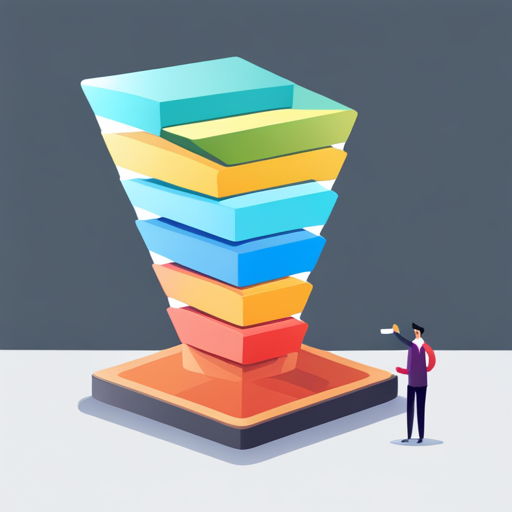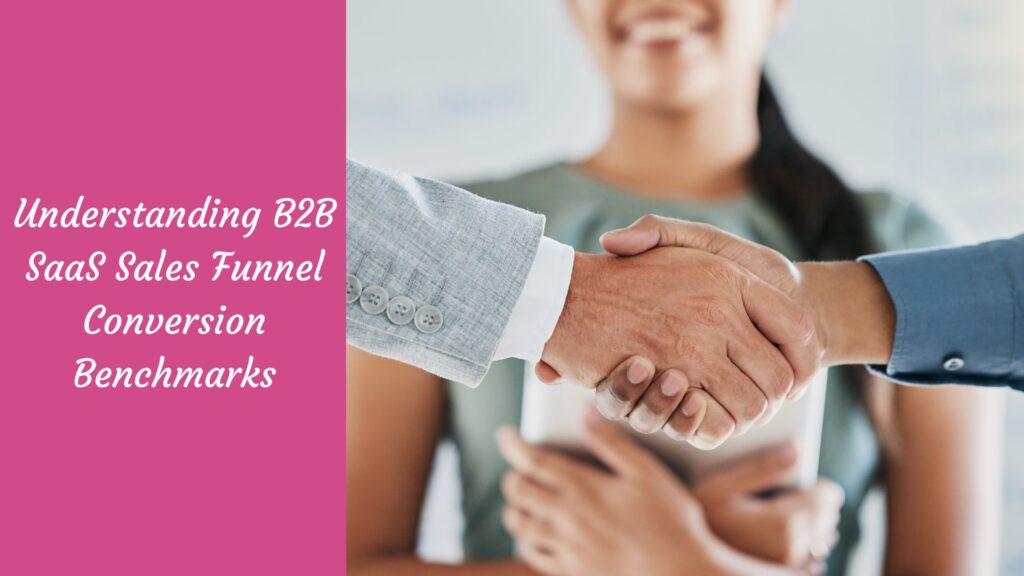As a B2B SaaS owner, you understand the importance of a steady flow of leads in your sales funnel. But it’s not just about quantity – it’s about converting those leads into paying customers. That’s where a well-crafted sales funnel becomes crucial.
So, how do you determine if your sales funnel is performing well or if it needs improvement?
In this captivating blog post, we’ll dive into B2B SaaS sales funnel conversion benchmarks, giving you insights on what to aim for in your sales journey. Get ready to take your sales funnel to new heights!
What is b2b saas sales funnel?

A B2B (Business-to-Business) SaaS (Software-as-a-Service) sales funnel is a representation of the journey that potential customers go through, from the initial stage of awareness to the final stage of becoming a customer. Here’s a more in-depth breakdown:
- Lead Generation: This is the first level of the funnel where potential clients are identified. Examples can include activities like content marketing, where you might publish a blog post on “Improving Business Efficiency with SaaS” to attract interest.
- Lead Nurturing: This is where interested individuals or companies have been identified as leads and further information is provided to them to pique their interest. A webinar or an in-depth guide on “Maximizing Business Performance with SaaS” might be used here.
- Evaluation: At this stage, the leads are evaluating whether your SaaS solution meets their needs. A product demo or a free trial can serve as effective tools at this phase of the funnel.
- Decision: This final stage involves the lead deciding whether to become a paying customer. After using your SaaS product during the trial period, they might choose to purchase a subscription and become a regular user.
To start, let’s define what a sales funnel is. A sales funnel is a visual representation of the customer journey from the first point of contact with your company to when they become paying customers. The sales funnel may have different stages, depending on your company’s specific sales process. However, the most common stages are awareness, interest, consideration, and decision.
Now, let’s dive into the conversion benchmarks for each stage of the sales funnel. According to research done by HubSpot, the average conversion rates for B2B SaaS businesses are as follows:

Awareness stage: 3%

Interest stage: 20%

Consideration stage: 28%

Decision stage: 4%
Now, these are just benchmarks, and your own conversion rates may be higher or lower than these numbers. However, they do give you some idea of what to aim for. For example, if your awareness stage conversion rate is only 1%, you know that there’s room for improvement in your lead generation efforts or your messaging.
Another metric to keep in mind is the overall conversion rate from lead to customer. This is the percentage of leads that become paying customers, regardless of their stage. According to a Smart Insights study, the average B2B SaaS conversion rate is around 3%. Again, this is an average, and your own conversion rate may be higher or lower.
However, it’s a good metric to keep in mind as you evaluate the effectiveness of your sales funnel.
There are many ways to improve your conversion rates at each stage of the sales funnel. For example, at the awareness stage, you could focus on improving your SEO so that more people discover your website. At the interest stage, create content addressing your target audience’s pain points and challenges.
At the consideration stage, you could offer free trials or demos to help prospects experience your product firsthand. And at the decision stage, you could offer incentives like discounts or bonuses to encourage prospects to become paying customers.
Finally, it’s important to track your conversion rates over time. This will give you an idea of how effective your sales funnel is and where you need to make improvements. There are many tools available, such as Google Analytics and Salesforce, that can help you track conversion rates and other metrics.
FAQs
What is a SaaS conversion?
A SaaS conversion is the process where a visitor or lead in the software-as-a-service (SaaS) business model takes a desired action. This action could be signing up for a free trial, purchasing a subscription, or upgrading to a higher service tier. Here are some examples:
- Trial to Paid Conversion: This is when a user who has signed up for a free trial of your software decides to become a paying customer. For instance, if a user was trialing a project management software and found it useful, they might decide to subscribe to a paid plan once their trial period ends.
- Freemium to Paid Conversion: In a freemium model, customers can use the basic features of a software for free, but must pay to access premium features. A conversion occurs when a freemium user decides to upgrade to a premium plan. An example of this would be someone using the free version of a music streaming service like Spotify, but deciding to upgrade to Spotify Premium to enjoy additional benefits such as ad-free listening and offline mode.
- Visitor to Lead Conversion: A visitor becomes a lead when they share their contact information in exchange for something of value. For example, a visitor to a CRM software’s website might fill out a form to download an informative e-book about customer relationship management, thus becoming a lead.
What are the stages of a B2B SaaS conversion funnel?
The stages of a B2B SaaS conversion funnel typically include:
- Awareness: This initial stage is all about generating buzz around your product. This could involve content marketing, social media campaigns, or SEO efforts. For instance, tech companies often publish thought leadership articles or sponsor industry events to attract potential customers.
- Interest: Once a potential customer is aware of your product, the goal is to pique their interest. In this stage, they might read blog posts on your site or watch your webinars to learn more about your offering. For example, a restaurant management software company might host a webinar on ‘Improving Restaurant Efficiency in the Post-COVID Era’.
- Consideration: At this point, the potential customer is comparing your product with others on the market. They might sign up for free trials or demos to see your product in action. An example would be a potential customer trying out several email marketing tools to see which one best fits their needs.
- Conversion: This is the stage where the lead becomes a customer. They decide to purchase your product after considering all the available options. For example, a lead might choose the ‘Pro’ plan of your HR software after a successful trial period.
- Retention: The final stage is about keeping the customer satisfied and ensuring they continue to use your product. This can involve providing excellent customer service, updating and improving the product, and offering customer loyalty programs. An example would be a CRM software company regularly releasing new features based on customer feedback.
What is a good conversion rate in SaaS?
The concept of a “good” conversion rate in the Software as a Service (SaaS) industry can vary significantly, influenced by numerous factors including the niche, target audience, and the company’s specific business model.
However, as a rough ballpark, many industry experts suggest that a conversion rate between 3% to 5% is a solid benchmark for SaaS businesses. For instance, if your website or application has 10000 visitors per month, and 300 to 500 of them become paying customers, you would be within this target range.
But remember, these figures are just averages. Some successful SaaS businesses have managed to achieve even higher conversion rates. The key is to continually test and refine your sales and marketing strategies to boost your own conversion rates, irrespective of what the average might be.
What are some b2b saas sales funnel benchmarks?
B2b saas sales funnel conversion benchmarks vary, but here are a few common ones to consider:
- Visitor to Lead: A solid benchmark for converting a website visitor to a lead is around 2% to 3%. For instance, if a SaaS company specializing in project management software gets 20,000 visitors per month, they might aim for 400 to 600 of those visitors to fill out a contact form or sign up for a free trial.
- Lead to Customer: When it comes to converting a lead to a paying customer, a good benchmark might be in the neighborhood of 20% to 25%. As an example, a sales automation SaaS might hope to convert 100 out of every 500 leads into customers.
- Trial to Paying Customer: For SaaS companies offering free trials, conversion rates from trial user to paying customer typically hover around 15% to 20%. For example, an email marketing SaaS with 500 trial users might aim to convert 75 to 100 of those users into paying customers.
- Churn Rate: It’s also crucial to consider churn rate—the percentage of users who cancel their subscription within a certain time period. A healthy churn rate for a SaaS company might be around 5% to 7% annually. So, a cloud storage SaaS company with 1,000 customers would aim to lose no more than 50 to 70 of those customers over a year.
Remember, these are just benchmarks and the actual numbers can vary based on a variety of factors. The most important thing is to track your own metrics, iterate on your strategies, and strive for continual improvement.
What strategies can I use to improve my SaaS conversion rate?
Here are a few strategies you can employ to improve your SaaS conversion rate:
- Implement a Freemium Model: Offer potential customers a free version of your software with limited features. A project management software could have a free version that supports up to 3 projects. This gives users a chance to explore and appreciate your service, encouraging them to upgrade for more functionalities.
- Provide Excellent Customer Support: This cannot be overstated. Quick and efficient customer support can significantly reduce churn rate. For instance, a cloud storage SaaS company could provide 24/7 live chat support to respond to customer queries promptly.
- Optimize Your Website: Ensure your website is user-friendly and communicates your value proposition clearly. For example, an email marketing SaaS could highlight features like ease of use, customizable templates, and robust analytics on their landing page.
- Offer a Robust Onboarding Experience: Help new customers understand and appreciate the full value of your software. An automation SaaS might incorporate interactive tutorials or in-app guidance for first-time users.
- Leverage Email Marketing: Regularly communicate with your leads and customers, providing them valuable content, updates, and offers. For instance, a project management software company could send monthly newsletters with productivity tips, new feature updates, and special promotions.
Remember, the key to improving your conversion rate is understanding your customer’s needs and continuously delivering value.
Conclusion
Understanding B2B SaaS sales funnel conversion benchmarks is crucial for boosting your sales process and achieving revenue goals. But remember, these benchmarks are just a starting point. Your conversion rates may vary. By tracking your rates, refining your sales funnel, and leveraging the right tools, you can convert more leads into paying customers and fuel business growth. Keep these tips in mind, and let’s supercharge your sales funnel to drive revenue for your B2B SaaS business!

10+ years experience in Marketing and Operations
